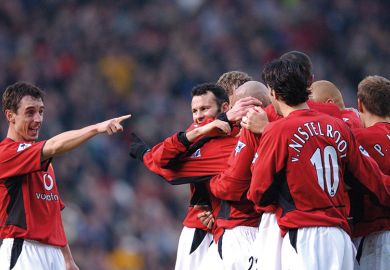Pep Guardiola’s introduction of “false nine” strikers and playmaker goalkeepers are credited with revolutionising European football, but could the Manchester City manager’s tactical innovations also improve how science is conducted?
Absolutely, says one California-based scientist who has written a 21-page treatise on how scientific laboratories could learn from football’s most inventive thinkers, especially those who have transformed the game in the past two decades.
In his recent paper in the journal Retos, Vuk Uskoković, a lecturer at San Diego State University, explains how the thousands of different plays that can be achieved on a pitch, and the need to balance tactical rigidity with individual flair, provide a good way in which to view the teamwork dynamics within labs – where outstanding talent is also just one ingredient of success.
“In basketball, the plays are far more limited – pick-and-roll, run-and-gun – but football has 11 players a side and enough space on a pitch for countless combinations of passes,” said Dr Uskoković, who explained that the huge potential for different plays – in which the strongest, fastest and most skilful team does not always win – invited viewers to see the game through a “scientific mindset”.
Pioneers such as Mr Guardiola, who upset orthodoxy by insisting that “most players should be in midfield” or that “total football” should begin with the goalie – even if errors lead to goals – could be emulated in the scientific lab, continued Dr Uskoković, whose research has focused on nanotechnology in chemistry.
“Football is a good way to think about how we can approach science and education differently,” he said. “For instance, we will often give a specific role to each member of the lab and ask them to work on one piece of equipment – the electroscopy or PCR machine, say – because it’s seen as more efficient, but it’s also very limiting. We should be thinking more about total football.”
Many of the tactical innovations discussed by Dr Uskoković have a distinct Balkan flavour, highlighting how the likes of Hungary, Croatia and the former state of Yugoslavia have punched above their weight in football terms over the years thanks to smart management.
In a similar way, smaller and less well-resourced laboratories could also outperform research teams at behemoth institutions, according to Dr Uskoković.
“I grew up in Belgrade in the 1980s and saw my country split into two main parts – Croatia and Serbia. The first has reached the World Cup final and the semis twice while the second has never reached the quarter-finals,” he said.
“If you look at the history of these teams – both of which I have much affection for – you can see certain strategic decisions have had huge implications for sporting success. The same is also true for the decisions we make around science.”
Register to continue
Why register?
- Registration is free and only takes a moment
- Once registered, you can read 3 articles a month
- Sign up for our newsletter
Subscribe
Or subscribe for unlimited access to:
- Unlimited access to news, views, insights & reviews
- Digital editions
- Digital access to THE’s university and college rankings analysis
Already registered or a current subscriber?








